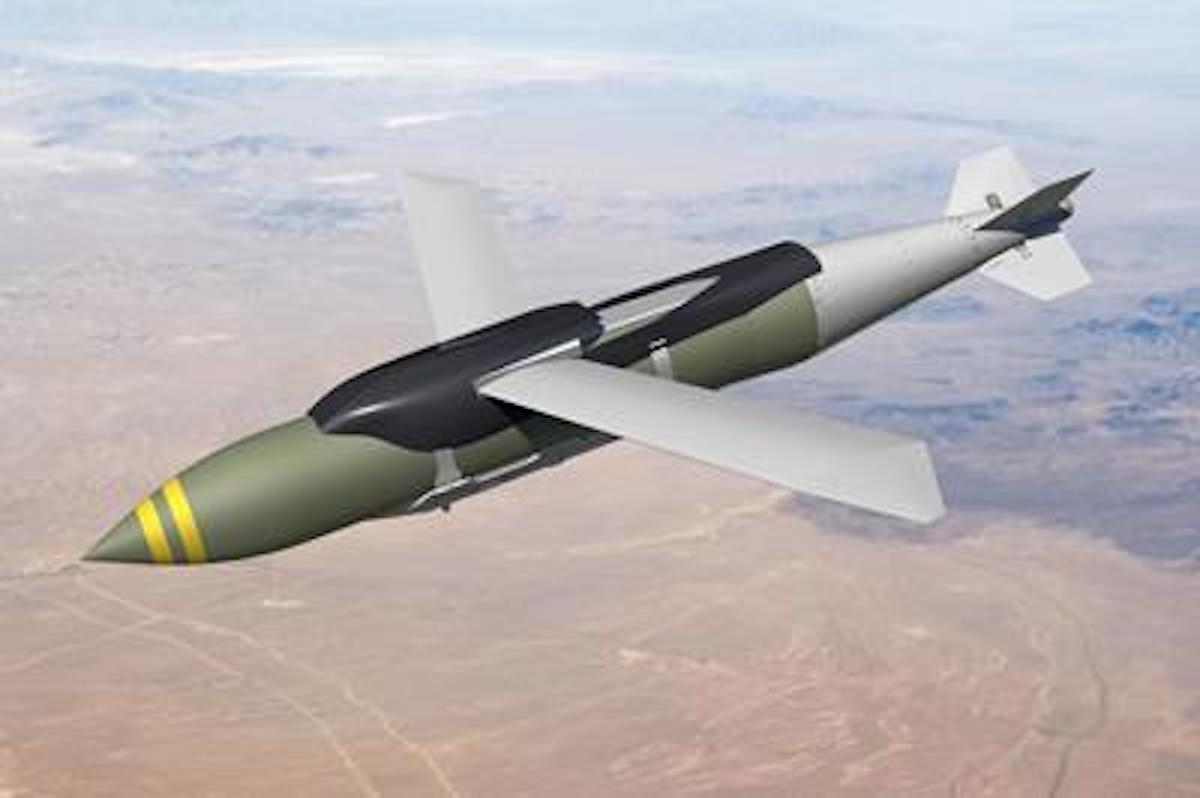Global Courant 2023-04-21 02:26:18
The Ukrainians use US-supplied slide bombs and the Russians have their own.
These weapons are new to the war in Ukraine and so far the Russians are winning the slide bomb battle. The Ukrainians shout the Russian slidebombs an “extremely large threat”.
The US has supplied Ukraine with two different types of slide bombs, the GLSDB (small diameter ground-launched bomb) produced by Boeing and Saab (Sweden), and the JDAM-ER (joint direct attack munition – extended range), manufactured by Boeing. Boeing has evolved over the years produced over 500,000 JDAMs.
Russia has responded with two types of precision bombs, the Grom E2 and the UPAB-1500B-E.
Surprisingly, the weapons supplied by the US have been ineffective and have been intercepted by the Russians.
Photo: Screenshot / YouTube / Hindustan Times
The Russian Grom E2 also experienced mechanical or electronic malfunctions. But the UPAB-1500B is a different story: it proves to be effective and reliable in limited use. Ukraine has so far failed to block or shoot down UPAB bombs.
There is a difference between a slide bomb and a guide bomb. A guided bomb is aimed at its target from the cockpit of the aircraft and released. The bomb is controllable. A slide bomb is distinguished by being released and sliding towards its target. While it can be controlled by a pilot or copilot, it usually operates autonomously once released.
Guided bombs date back to World War I and were used by the Germans against warships in World War II. The most successful was the Fritz-X built between 1943 and 1944. It was the first guided bomb to sink an Allied warship.
Guided bombs have very short ranges. Usually a guided bomb is controlled by the pilot or copilot of the launching aircraft and the targeting is visual.
The American JDAM-ER, now in use in Ukraine, is a kit attached to an unguided (“dumb”) bomb. The kit includes the guidance package, which is a combination of a GPS receiver and inertial navigation system, a control package, and aerodynamic lifting and control surfaces for the bomb to glide and maneuver.
The control package receives commands from the launching aircraft, but since the aircraft will be far from the target, the target location information must be entered into the JDAM by an observer, either on the ground before takeoff or information obtained from a drone.
JDAM-ER is not suitable for moving targets. JDAM has vulnerabilities through its data link and its GPS. The Russians claim they have successfully blocked JDAMs launched by Ukrainian aircraft and this claim has been confirmed in leaked classified documents.
If GPS is blocked (and not spoofed), the hovercraft relies solely on the internal navigation system on board. Low-end INS systems must be constantly updated to maintain operational accuracy. For example, a jammed bomb will drift off the target and be ineffective. For example, JDAM would go from an accuracy, expressed in circular probability error, of 5 meters CEP (16 feet) to 30 meters (99 feet). One of the risks of these weapons is that, if jammed, they could hit vulnerable civilian installations (e.g. apartment buildings).
JDAM kits can be mounted on different sized bombs, for example 500lb, 1000lb or even 200lb bombs. They can achieve a long range, provided the aircraft is flying at a level of 35,000 feet or level 35 (10,668 meters), which gives a JDAM-ER a maximum range of 72 km (44.7 mi).
The plane doesn’t just have to climb to altitude, though; it must be level and operating at top speed for the JDAM to have the speed it needs to reach its target. Unfortunately, among its aircraft, Ukraine has only the MIG-29 who can work at level 35.
If the JDAM is on a less suitable platform, such as a Su-25, it will have a considerably shorter range. Because the Russians have advanced versions of the S-300 and a few S-400 air defense units in Ukraine, they can pick off the Ukrainian planes with air defense missiles, or challenge them in air-to-air combat, making it difficult for Ukrainian pilots to get close enough to launch against enemy targets.
The US small diameter ground-launched bomb (GLSDB) has a 250-pound warhead. It can be launched by HIMARS in Ukraine or from MLRS (multiple-launch rocket systems) or other launchers. Like the JDAM, it is guided by GPS and INS. It is fired from a launch tube using a small rocket, which detaches, after which the GLSDB glides towards its target. It’s slower than a standard HIMARS, meaning it’s easier to intercept.
GLDSB has the same vulnerabilities as JDAM, but the advantage is that it is ground-launched and, when mounted on a gun-and-scoot platform like HIMARS, is difficult to locate for Russian artillery or aircraft. GLSDB has a claimed range of 150 km (93 mi).
The Russian UPAB-1500B-E is a slide bomb that uses the Russian one Glonass GPS system and an inertial guidance system. On March 24, a group of 10 Su-35 aircraft launched UPABs against targets in Sumy province, Ukraine. It’s not clear how many Upabs actually dropped, but the system worked.
The most dramatic demonstration occurred on or about April 18, when a single 1,500-pound UPAB crashed into a fortified Ukrainian position in western Bakhmut. The blast unleashed a mushroom-like cloud that was visible for miles. A day later, more UPABs were launched in other disputed areas along the contact line in Ukraine.
The Ukrainians so far found no way to stop the UPAB. Part of this is due to the severely degraded Ukrainian air defenses, making shootings difficult. Ukraine may also have problems trying to block the UPAB Glonass GPS, suggesting Western jamming devices are ineffective or not being used properly. Last May the US announced new jammers for the Ukrainian army.
Both JDAM and UPAB are ranged weapons and both are relatively cheap and quick to manufacture. They can do the same job as tactical cruise missiles for a fraction of the cost. In the future, however, with increasingly sophisticated jammers, sliding weapons will have to evolve.
A new generation of sliding weapons
The next stage in sliding weapons will be systems that can operate in environments without GPS. A good example of an autonomous hover bomb that can operate when GPS is blocked and maintain high accuracy is that of Rafael (Israel) SPICE family of bomb kits. The kits convert general-purpose penetration warheads weighing 1,000 or 2,000 pounds into precision ranged weapons with a range of 60–100 km (37 to 62 mi).
Wave of the future? SPICE-250 standoff, autonomous, air-to-ground weapons system. Photo: Raphael
According to Rafael, SPICE uses advanced EO/IR (electro-optical and infrared) technologies to target, acquire and autonomously track moving targets. path adjustment and minimal collateral damage.
Rafael teams up with Lockheed Martin to offer SPICE to the US military.
The use of scene matching technology is spreading as GPS vulnerabilities become more pronounced. A scene match occurs when a pre-programmed target scene is saved in the weapon computer. When it “sees” the same scene, it will aim for that target.
The first significant use of scene matching was in Tomahawk cruise missiles. The system was called TERCOM. The early versions of the Tomahawk relied primarily on scene matching in conjunction with the missile’s inertial navigation system (INS). GPS was added later because early Tomahawks used scene tuning for their entire flight path, which meant scene preparation required extensive reconnaissance and the flight path for Tomahawk was predictable, adding to Tomahawk’s vulnerability to anti-aircraft and missile defense systems. Tomahawk cruise missiles fly at low altitudes to evade radar and operate at subsonic speed.
The Russians also adopted scene matching systems similar to Tomahawk – including the SS-NX-21 submarine launched cruise missile (S-10 Granit) and the R-55 (later KH-55) land-based cruise missile. Russia did it first TERCOM-based cruise missiles early eighties.
Tomahawk could not go after moving targets. But the advanced camera pods and scene-matching algorithms make it possible to hit moving targets like tanks and mobile systems like HIMARS. As artificial intelligence capabilities are built into hover weapons, the capabilities will continue to grow.
One of the lessons we have learned in Ukraine, which is in serious trouble on both sides, is that autonomous glide weapons that rely on GPS must be replaced by systems that can operate accurately without GPS. The use of scene tuning, excellent cameras capable of day or night, and algorithms that rely on artificial intelligence will be urgently needed for battlefield survival weapons.
Stephen Bryen is a senior fellow at the Center for Security Policy and at the Yorktown Institute.
Similar:
Loading…








